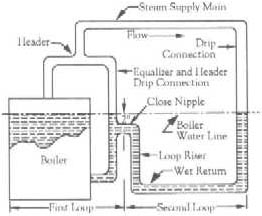 |
 A Hartford Loop is an arrangement of piping between a steam boiler's header and its gravity-return piping. The end of the header drops vertically below the boiler's waterline and connects into the bottom of the boiler. We call this pipe the "equalizer" because it balances the pressure between the boiler's steam outlet and condensate-return inlet. The "wet" gravity return line, which returns the condensate from the system, rises up from the floor to join with the equalizer at a point about two inches below the boiler's lowest operating water line. A Hartford Loop is an arrangement of piping between a steam boiler's header and its gravity-return piping. The end of the header drops vertically below the boiler's waterline and connects into the bottom of the boiler. We call this pipe the "equalizer" because it balances the pressure between the boiler's steam outlet and condensate-return inlet. The "wet" gravity return line, which returns the condensate from the system, rises up from the floor to join with the equalizer at a point about two inches below the boiler's lowest operating water line. The Dead Men didn't always use this piping arrangement. They used to bring the return directly back into the bottom of the boiler without benefit of either a Hartford Loop or an equalizer. When they piped a boiler this way, however, the slightest steam pressure would push water out of the boiler and into the return. They solved this problem by using a check valve in the wet return (that's the pipe below the boiler water line). Before long, though, they found the check valve would fill with sediment and get stuck open. That caused the water to back out of the boiler again, so they developed the equalizer pipe to replace the check valve. Whatever pressure appears inside the boiler will also appeared inside the equalizer pipe if you size that pipe properly. The two forces balance each other, and the water stays in the boiler.
Now, you may wonder what happens if a return line breaks. Well, water will flow from the boiler, and the boiler will either crack (dry-fire) or explode (if someone adds water while it's dry-firing). That's a sobering thought, isn't it? Keep in mind there were no low-water cutoffs during the days of coal- and wood-fired boilers. E. N. McDonnell of McDonnell & Miller fame invented the first low-water cutoff in 1923. He had to wait for the invention of the oil burner before his product made any sense. Around 1919, the Hartford Steam Boiler Insurance and Inspection Company got tired of paying the claims on all those broken boilers, so they came up with the idea of this special piping configuration and mandated it for anyone who wanted insurance on their steam boiler. Before long, everyone was calling it the Hartford (or Underwriters) Loop. If you look at the records of boiler failures before and after 1919, you can see that the Loop had a very positive impact on our industry. Here's how the Hartford Loop works. If a return line breaks, water can only back out of the boiler to the point where the wet return line connects into the equalizer. The Loop works like a siphon that runs out of water. The point where the Loop connects to the equalizer is higher than the boiler's crown sheet, and that's what provides the safety. Since the water couldn't instantly vanish from the boiler, it bought the Dead Men some time to notice the problem and save that wood- or coal-fired boiler. The piping arrangement wasn't fail-safe, but it was a vast improvement over the old way of returning condensate directly into the bottom of the boiler. Should you use a Hartford Loop nowadays? I sure think so! Your low-water cutoff should protect the boiler against a sudden loss of water, but if you have a gravity-return system, a Hartford Loop is the cheapest insurance you can buy to back up that low-water cutoff should a return rupture and water suddenly leave the boiler. Low-water cutoffs are great, but believe it or not, there are a few out there that don't get blown-down once a week. Really! The Loop connects into the equalizer through a close nipple and here's why. Steam rises up through the equalizer, just as it does through the boiler sections. When the relatively cool return water meets that steam at the close nipple, the rising steam bubbles quickly condense. Naturally, the return water rushes in to fill the void left by the collapsing bubbles, and this creates a slight water hammer inside the tee connecting the return to the equalizer. If you use a long nipple instead of a close nipple, the returning water will have more room to move, so it creates more water hammer through its inertia. Long nipples acts like gun barrels in this case, and you should always avoid them. Stick with a close nipple, or use a "Y" fitting. Generally, you should connect the close nipple about two inches below the bottom of the gauge glass, but check the boiler manufacturer's specs on this. The centerline of the close nipple has to be below the water line, but above the boiler's crown sheet. |